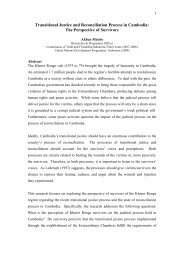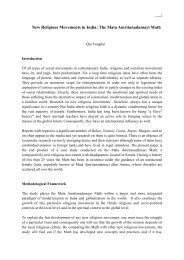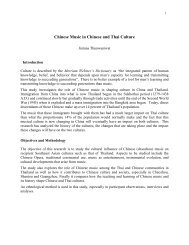Private Sector Participation in Affirmative Action in Malaysia: - Asian ...
Private Sector Participation in Affirmative Action in Malaysia: - Asian ...
Private Sector Participation in Affirmative Action in Malaysia: - Asian ...
Create successful ePaper yourself
Turn your PDF publications into a flip-book with our unique Google optimized e-Paper software.
The <strong>Malaysia</strong>n experience provides useful <strong>in</strong>sights to India on how to implement<br />
‘diversity’ <strong>in</strong> the private sector, the l<strong>in</strong>k between diversity and <strong>in</strong>centives, and the<br />
possible reconciliation of private-sector goals (merit and efficiency) with government’s<br />
priorities for <strong>in</strong>clusion and equity.<br />
Introduction<br />
Most governments around the world have adopted a wide range of affirmative action<br />
policies to address the problems of <strong>in</strong>equality and exclusion. Broadly conceived,<br />
affirmative action is a term that refers to measures or practices that seek to elim<strong>in</strong>ate<br />
discrim<strong>in</strong>atory practices by permitt<strong>in</strong>g the consideration of race, ethnicity, sex, or<br />
national orig<strong>in</strong> <strong>in</strong> the availability of opportunity for a class of qualified <strong>in</strong>dividuals that<br />
have been the victims of historical, actual, or recurr<strong>in</strong>g discrim<strong>in</strong>ation (Sabbagh, 2004).<br />
Although goals of these (affirmative) policies may appear similar, there are wide<br />
variations <strong>in</strong> their scope, nature and implementation strategy. <strong>Affirmative</strong> action could be<br />
compensatory or used to bridge the economic and socio-political gap between groups or<br />
empower disadvantaged groups (Ratuva, 2002). Sometimes, it is embodied and enforced<br />
through constitutional provisions as <strong>in</strong> India, <strong>Malaysia</strong>, Fiji and South Africa, while at<br />
times it can be articulated through legislations or executive orders as <strong>in</strong> the US.<br />
In some cases, they could be just part of the economic and social policies of the<br />
government of the day, either as part of its welfare policies or for political expediency<br />
and utility such as w<strong>in</strong>n<strong>in</strong>g political allegiance and votes. Often development bluepr<strong>in</strong>ts<br />
are drawn up specify<strong>in</strong>g the general pr<strong>in</strong>ciples and specific policies for preferential<br />
distribution of jobs, scholarship, capital <strong>in</strong>vestment and commercial enterprise,<br />
parliament seats and use of state <strong>in</strong>frastructure and utilities. Often quotas are used to<br />
determ<strong>in</strong>e the distribution of benefits. In short, affirmative action is quite popular with<br />
governments around the world and they do not restrict necessarily to democracy alone.<br />
Even totalitarian countries like Ch<strong>in</strong>a have promoted such programmes (Retuva, 2002).<br />
2







